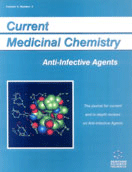Abstract
Farnesyltransferase catalyzing the transfer of a farnesyl residue from farnesylpyrophosphate to the thiol of a cysteine side chain of proteins carrying the C-terminal CAAX-tetrapeptide sequence has been one of the prime targets in the development of novel anti-cancer agents. From numerous farnesyltransferase inhibitors that have been described, several have reached advanced stages of clinical trials. In addition to mammals, farnesyltransferases were also identified in different pathogenic protozoa including Plasmodium falciparum, the causative agent of malaria tropica. Therefore, inhibition of farnesyltransferase has also been suggested as a new strategy for the treatment of parasitic infections. The overall sequence identity of human and P. falciparum farnesyltransferase is considerably low, however, amino acid differences in the active sites are rather small. Only few inhibitors have been assayed against P. falciparum farnesyltransferase; some of them displayed high activity against the isolated enzyme but were only moderately active when assayed against blood stages of P. falciparum. A number of established farnesyltransferase inhibitors or derivatives of them are highly active against the human enzyme or against human cancer cells, but generally displayed only micromolar activity against P. falciparum blood stages. However, there are examples of various inhibitors with nanomolar in vitro activity against P. falciparum. In a mouse model, activity has also been demonstrated in vivo. This may justify further efforts in the development of specific anti-malarial farnesyltransferase inhibitors.
Keywords: malaria, plasmodium falciparum, farnesyltransferase inhibitors, protein prenylation
 2
2

